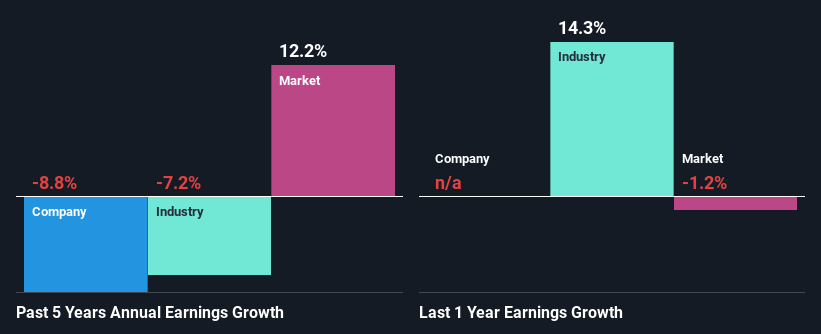Can Lancashire Holdings Limited (LON:LRE) Performance Keep Up Given Its Mixed Bag Of Fundamentals?
Lancashire Holdings' (LON:LRE) stock is up by 6.6% over the past three months. However, the company's financials look a bit inconsistent and market outcomes are ultimately driven by long-term fundamentals, meaning that the stock could head in either direction. Particularly, we will be paying attention to Lancashire Holdings' ROE today.
Return on equity or ROE is a key measure used to assess how efficiently a company's management is utilizing the company's capital. In other words, it is a profitability ratio which measures the rate of return on the capital provided by the company's shareholders.
See our latest analysis for Lancashire Holdings
How To Calculate Return On Equity?
ROE can be calculated by using the formula:
Return on Equity = Net Profit (from continuing operations) ÷ Shareholders' Equity
So, based on the above formula, the ROE for Lancashire Holdings is:
8.5% = US$125m ÷ US$1.5b (Based on the trailing twelve months to June 2023).
The 'return' is the profit over the last twelve months. So, this means that for every £1 of its shareholder's investments, the company generates a profit of £0.09.
What Is The Relationship Between ROE And Earnings Growth?
Thus far, we have learned that ROE measures how efficiently a company is generating its profits. Based on how much of its profits the company chooses to reinvest or "retain", we are then able to evaluate a company's future ability to generate profits. Assuming all else is equal, companies that have both a higher return on equity and higher profit retention are usually the ones that have a higher growth rate when compared to companies that don't have the same features.
Lancashire Holdings' Earnings Growth And 8.5% ROE
When you first look at it, Lancashire Holdings' ROE doesn't look that attractive. However, given that the company's ROE is similar to the average industry ROE of 8.5%, we may spare it some thought. But Lancashire Holdings saw a five year net income decline of 8.8% over the past five years. Remember, the company's ROE is a bit low to begin with. Hence, this goes some way in explaining the shrinking earnings.
Next, when we compared with the industry, which has shrunk its earnings at a rate of 7.2% in the same 5-year period, we still found Lancashire Holdings' performance to be quite bleak, because the company has been shrinking its earnings faster than the industry.

Earnings growth is a huge factor in stock valuation. The investor should try to establish if the expected growth or decline in earnings, whichever the case may be, is priced in. This then helps them determine if the stock is placed for a bright or bleak future. If you're wondering about Lancashire Holdings''s valuation, check out this gauge of its price-to-earnings ratio, as compared to its industry.
Is Lancashire Holdings Efficiently Re-investing Its Profits?
Looking at its three-year median payout ratio of 47% (or a retention ratio of 53%) which is pretty normal, Lancashire Holdings' declining earnings is rather baffling as one would expect to see a fair bit of growth when a company is retaining a good portion of its profits. So there could be some other explanations in that regard. For instance, the company's business may be deteriorating.
In addition, Lancashire Holdings has been paying dividends over a period of at least ten years suggesting that keeping up dividend payments is way more important to the management even if it comes at the cost of business growth. Upon studying the latest analysts' consensus data, we found that the company's future payout ratio is expected to drop to 37% over the next three years. As a result, the expected drop in Lancashire Holdings' payout ratio explains the anticipated rise in the company's future ROE to 21%, over the same period.
Summary
On the whole, we feel that the performance shown by Lancashire Holdings can be open to many interpretations. While the company does have a high rate of reinvestment, the low ROE means that all that reinvestment is not reaping any benefit to its investors, and moreover, its having a negative impact on the earnings growth. Having said that, looking at current analyst estimates, we found that the company's earnings growth rate is expected to see a huge improvement. To know more about the latest analysts predictions for the company, check out this visualization of analyst forecasts for the company.
Have feedback on this article? Concerned about the content? Get in touch with us directly. Alternatively, email editorial-team (at) simplywallst.com.
This article by Simply Wall St is general in nature. We provide commentary based on historical data and analyst forecasts only using an unbiased methodology and our articles are not intended to be financial advice. It does not constitute a recommendation to buy or sell any stock, and does not take account of your objectives, or your financial situation. We aim to bring you long-term focused analysis driven by fundamental data. Note that our analysis may not factor in the latest price-sensitive company announcements or qualitative material. Simply Wall St has no position in any stocks mentioned.
